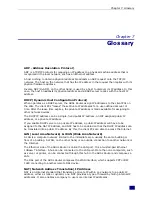
Chapter 7: Glossary
75
If the IP addresses given by your ISP are not enough for each PC on the LAN and the ADSL
Router, you need to use NAT. With NAT, you make up a private IP network for the LAN and
assign an IP address from that network to each PC. One of some public addresses is
configured and mapped to a private workstation address when accesses are made through
the gateway to a public network.
For example, the ADSL Router is assigned with the public IP address of 168.111.2.1. With
NAT enabled, it creates a Virtual LAN. Each PC on the Virtual LAN is assigned with a private
IP address with default value of 192.168.1.2 to 192.168.2.254. These PCs are not accessible
by the outside word but they can communicate with the outside world through the public IP
168.111.2.1.
Private IP Address
Private IP addresses are also LAN IP addresses, but are considered “illegal” IP addresses to
the Internet. They are private to an enterprise while still permitting full network layer
connectivity between all hosts inside an enterprise as well as all public hosts of different
enterprises.
The ADSL Router uses private IP addresses by assigning them to the LAN that cannot be
directly accessed by the Internet or remote server. To access the Internet, private network
should have an agent to translate the private IP address to public IP address.
Public IP Address
Public IP addresses are LAN IP addresses that can be considered “legal” for the Internet,
because they can be recognized and accessed by any device on the other side of the DSL
connection. In most cases they are allocated by your ISP.
If you are given a range of fixed IP addresses, then one can be assigned to the router and
the others to network devices on the LAN, such as computer workstations, ftp servers, and
web servers.
PVC (Permanent Virtual Circuit)
A PVC is a logical point-to-point circuit between customer sites. PVCs are low-delay circuits
because routing decisions do not need to be made along the way. Permanent means that the
circuit is preprogrammed by the carrier as a path through the network. It does not need to
be set up or torn down for each session.
RIP (Routing Information Protocol)
RIP is a routing protocol that uses the distance-vector routing algorithms to calculate least-
hops routes to a destination. It is used on the Internet and is common in the NetWare
environment. It exchanges routing information with other routers. It includes V1, V2 and
V1&V2, which controls the sending and receiving of RIP packets over Ethernet.
UDP (User Datagram Protocol)
UDP is a connectionless transport service that dispenses with the reliability services provided
by TCP. UDP gives applications a direct interface with IP and the ability to address a
particular application process running on a host via a port number without setting up a
connection session.
Virtual Server
You can designate virtual servers, e.g., a FTP, web, telnet or mail server, on your local
network and make them accessible to the outside world. A virtual server means that it is not
a dedicated server -- that is, the entire computer is not dedicated to running on the public
network but in the private network.
VPI (Virtual Path Identifier) & VCI (Virtual Channel Identifier)
A VPI is a 8-bit field while VCI is a 16-bit field in the ATM cell header. A
VPI
identifies a link
formed by a virtual path and a
VCI
identifies a channel within a virtual path. In this way, the
Summary of Contents for RTA230
Page 1: ...User Manual RTA230 ADSL Router Modem ...
Page 6: ...ADSL Router User Manual vi Appendix 78 Software 78 Hardware 79 ...
Page 75: ...Chapter 5 Connection Mode 67 9 Now the router is well configured You can access into Internet ...
Page 79: ...Chapter 5 Connection Mode 71 ...
Page 85: ...Chapter 7 Glossary 77 ...
Page 88: ...ADSL Router User Manual 80 ...






































